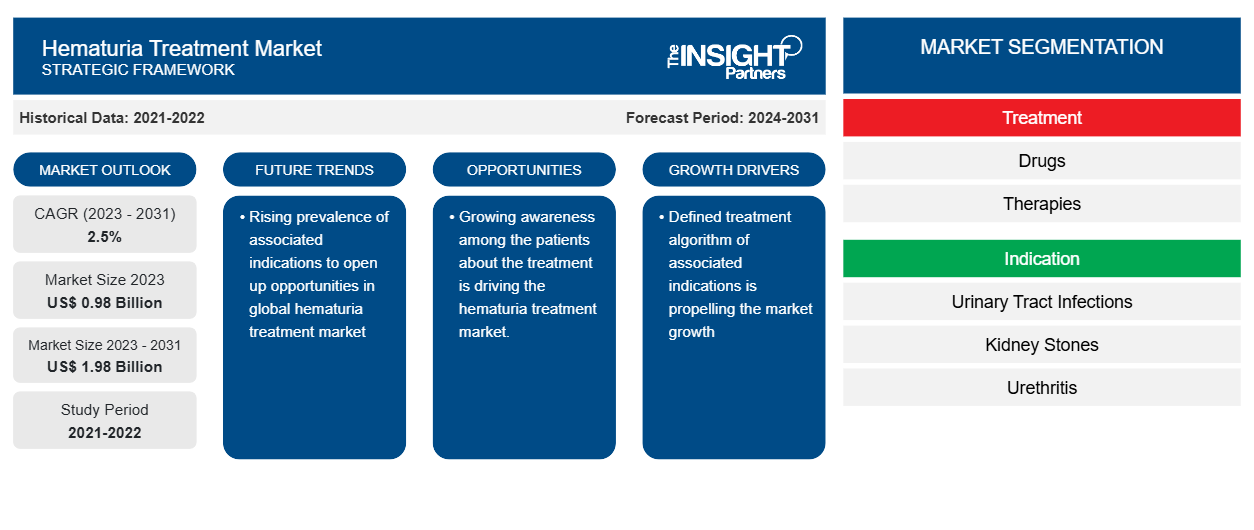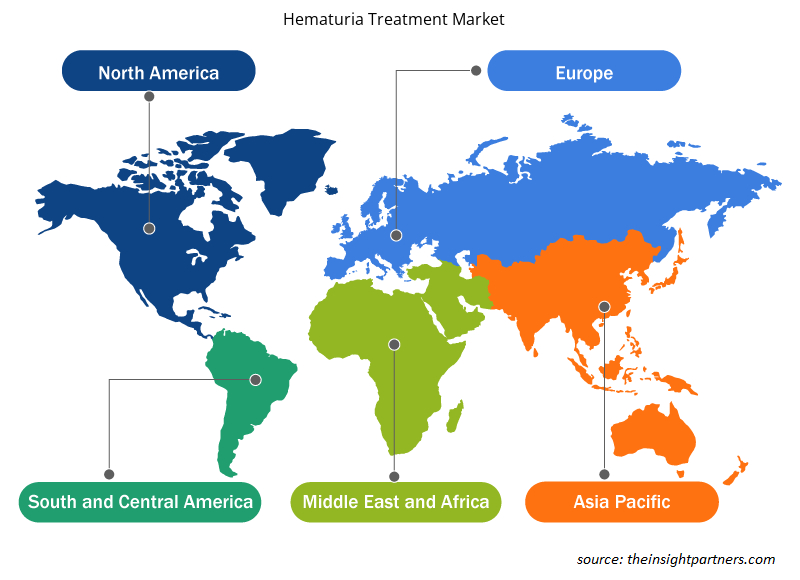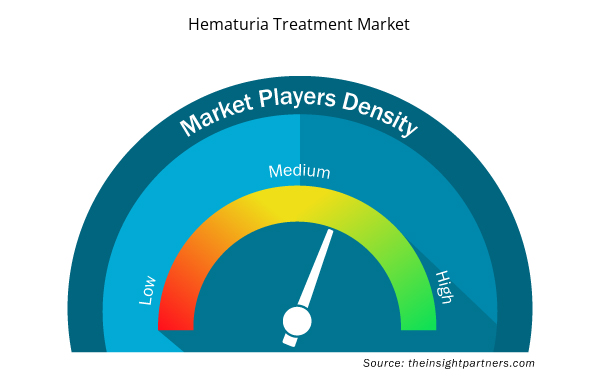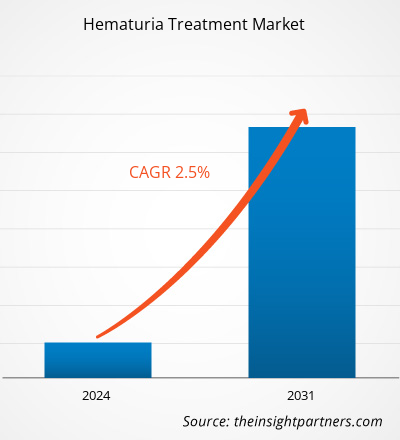The hematuria treatment market size is projected to reach US$ 1.98 billion by 2031 from US$ 0.98 billion in 2023. The market is expected to register a CAGR of 2.5% during 2023–2031. A rise in preference for advanced therapies will likely remain a key trend in the market.
Hematuria Treatment Market Analysis
The key factors that are driving the growth of the market are the high prevalence of hematuria-associated indications, increasing awareness about treatment options, and improving healthcare expenditure, which are factors propelling the hematuria treatment market. Furthermore, technological developments in medical devices and diagnostic procedures have led to various options for managing hematuria-associated indications, such as kidney stones, bladder stones, and urinary tract infections, which will likely offer opportunities to the hematuria treatment market in the coming years.
Hematuria Treatment Market Overview
Chronic kidney disease (CKD) is a common and life-threatening condition that affects a larger population worldwide. There are various types of CKDs, such as kidney stones, glomerulonephritis, polycystic kidney disease, and urinary tract infections. CKD is one of the fundamental causes behind the prevalence of hematuria. For instance, according to a study published in the National Center for Biotechnology Information in May 2019, urinary tract infections (UTIs) are generally observed as outpatient infections in the US, mostly occurring among women of the age group between 14 and 24 years. In addition, the prevalence of UTI among women over 65 years of age is about 20% compared to the overall population, which is about 11%. Currently, the global hematuria treatment market is gaining significantly from the increasing prevalence of associated indications.
Customize This Report To Suit Your Requirement
You will get customization on any report - free of charge - including parts of this report, or country-level analysis, Excel Data pack, as well as avail great offers and discounts for start-ups & universities
Hematuria Treatment Market: Strategic Insights

- Get Top Key Market Trends of this report.This FREE sample will include data analysis, ranging from market trends to estimates and forecasts.
Customize This Report To Suit Your Requirement
You will get customization on any report - free of charge - including parts of this report, or country-level analysis, Excel Data pack, as well as avail great offers and discounts for start-ups & universities
Hematuria Treatment Market: Strategic Insights

- Get Top Key Market Trends of this report.This FREE sample will include data analysis, ranging from market trends to estimates and forecasts.
Hematuria Treatment Market Drivers and Opportunities
Increasing Awareness About Treatment Options and Improving Healthcare Expenditure
Healthcare expenditure has considerably increased due to the rising prevalence of chronic indications. The governments of various economies are investing substantially in improving the healthcare infrastructure. For instance, as per the data published in December 2020 by the US Centers for Medicare & Medicaid Services (CMS), the National Health Expenditure (NHE) increased by about 4.6%, US$ 11,582 per person, and accounted for about 17.7% of gross domestic product (GDP). In addition, CMS projected that the health care spending in the US is expected to reach about US$ 6.19 trillion in April 2020.
Moreover, patients in developed economies are becoming aware of the possible treatments and availability of reimbursement for the hematuria treatment. Hematuria is among the initial indications of chronic diseases such as blood cancer, bladder cancer, and kidney cancer. These diseases are covered under various health insurance policies that help ease the treatment of the patients and reduce the financial burden of healthcare. Thus, improving healthcare expenditure and awareness among patients about the treatment is driving the hematuria treatment market.
Increasing Opportunities for Related Treatments
The aging population, which is more likely to acquire hematuria disease due to an increase in kidney stones and urinary tract infections, is one of the main drivers propelling the market's expansion. The use of advanced treatment technologies is expected to enhance patient care. For instance, the implementation of robotics in surgeries for treating urolithiasis has gained popularity in recent years. Currently, Vinci Surgical System, by Intuitive Surgical Inc., is widely used in performing surgeries to treat urolithiasis. Similarly, the uptake of endourological interventions for kidney stones has increased significantly across various North American, European, and Asian countries. It is also expected that advancements in associated indications will support the global hematuria treatment market during the forecast period.
Hematuria Treatment Market Report Segmentation Analysis
Key segments that contributed to the derivation of the hematuria treatment market analysis are product type, indication type, and end user.
- Based on treatment, the hematuria treatment market is segmented into drugs, therapies, and others. The drugs segment held the most significant market share in 2023.
- Based on indication, the hematuria treatment market is segmented by urinary tract infections, kidney stones, urethritis, blood cancer, bladder stones, prostate cancer, cystitis, trauma, vigorous exercise, polycystic kidney disease, endometriosis, menstruation. The urinary tract infections segment held the largest market share in 2023.
- Based on the end user, the hematuria treatment market is segmented by hospitals, clinics, and ASCs, among others. The hospital's segment held the largest market share in 2023.
Hematuria Treatment Market Share Analysis by Geography
The geographic scope of the hematuria treatment market report is mainly divided into five regions: North America, Asia Pacific, Europe, Middle East & Africa, and South & Central America.
In North America, the U.S. is the largest hematuria treatment market. The growth of this market is primarily driven by the increasing prevalence of chronic kidney disorders (CKD) and the growing number of product launches by key players. For instance, in 2016, the Centers for Disease Control and Prevention (CDC) stated that an estimated 0.7 million people were treated for end-stage renal disease (ESRD) in the U.S. The prevalence of ESRD more than doubled between 1990 and 2016. Moreover, the increase in the incidence of hematuria among adults, surge in awareness, and extensive research & development activities are also expected to drive the prevalence of hematuria treatments, which will eventually offer a lucrative opportunity for the growth of the market.
Hematuria Treatment Market Regional Insights
The regional trends and factors influencing the Hematuria Treatment Market throughout the forecast period have been thoroughly explained by the analysts at Insight Partners. This section also discusses Hematuria Treatment Market segments and geography across North America, Europe, Asia Pacific, Middle East and Africa, and South and Central America.

- Get the Regional Specific Data for Hematuria Treatment Market
Hematuria Treatment Market Report Scope
| Report Attribute | Details |
|---|---|
| Market size in 2023 | US$ 0.98 Billion |
| Market Size by 2031 | US$ 1.98 Billion |
| Global CAGR (2023 - 2031) | 2.5% |
| Historical Data | 2021-2022 |
| Forecast period | 2024-2031 |
| Segments Covered |
By Treatment
|
| Regions and Countries Covered | North America
|
| Market leaders and key company profiles |
Hematuria Treatment Market Players Density: Understanding Its Impact on Business Dynamics
The Hematuria Treatment Market market is growing rapidly, driven by increasing end-user demand due to factors such as evolving consumer preferences, technological advancements, and greater awareness of the product's benefits. As demand rises, businesses are expanding their offerings, innovating to meet consumer needs, and capitalizing on emerging trends, which further fuels market growth.
Market players density refers to the distribution of firms or companies operating within a particular market or industry. It indicates how many competitors (market players) are present in a given market space relative to its size or total market value.
Major Companies operating in the Hematuria Treatment Market are:
- AstraZeneca
- Merck & Co., Inc.
- Bristol-Myers Squibb Company
- Merck & Co., Inc.
- F. HOFFMANN-LA ROCHE LTD.
- GlaxoSmithKline plc.
Disclaimer: The companies listed above are not ranked in any particular order.

- Get the Hematuria Treatment Market top key players overview
Hematuria Treatment Market News and Recent Developments
The Hematuria Treatment Market is evaluated by gathering qualitative and quantitative data post primary and secondary research, which includes important corporate publications, association data, and databases. A few of the developments in the hematuria treatment market are listed below:
- AstraZeneca’s Farxiga (dapagliflozin) has been approved in the US to reduce the risk of cardiovascular (CV) death, hospitalization for heart failure (CHF), and urgent heart failure (HF) visits in adults with HF. The approval by the Food and Drug Administration (FDA) was based on positive results from the DELIVER Phase III trial.1 Farxiga was previously approved in the US for adults with HF with reduced ejection fraction (HFrEF). (Source: AstraZeneca’s, Company Website, May 2023)
Hematuria Treatment Market Report Coverage and Deliverables
The “Hematuria Treatment Market Size and Forecast (2021–2031)” report provides a detailed analysis of the market covering below areas:
- Hematuria treatment market size and forecast at global, regional, and country levels for all the key market segments covered under the scope
- Hematuria treatment market trends as well as market dynamics such as drivers, restraints, and key opportunities
- Detailed PEST/Porter’s Five Forces and SWOT analysis
- Hematuria treatment market analysis covering key market trends, global and regional framework, major players, regulations, and recent market developments.
- Industry landscape and competition analysis covering market concentration, heat map analysis, prominent players, and recent developments in the hematuria treatment market
- Detailed company profiles
- Historical Analysis (2 Years), Base Year, Forecast (7 Years) with CAGR
- PEST and SWOT Analysis
- Market Size Value / Volume - Global, Regional, Country
- Industry and Competitive Landscape
- Excel Dataset



Report Coverage
Revenue forecast, Company Analysis, Industry landscape, Growth factors, and Trends

Segment Covered
Treatment, Indication, Type, End User and Geography

Regional Scope
North America, Europe, Asia Pacific, Middle East & Africa, South & Central America

Country Scope
Argentina, Australia, Brazil, Canada, China, France, Germany, India, Italy, Japan, Mexico, Saudi Arabia, South Africa, South Korea, Spain, United Arab Emirates, United Kingdom, United States
Frequently Asked Questions
North America dominated the hematuria treatment market in 2023
The key factors that are driving the growth of the market are the high prevalence of hematuria-associated indications, increasing awareness about treatment options, and improving healthcare expenditure are factors propelling the hematuria treatment market.
A rise in Preference for Advanced Therapies will likely remain a key trend in the market.
AstraZeneca, Merck & Co., Inc., Bristol-Myers Squibb Company, Merck & Co., Inc., F. HOFFMANN-LA ROCHE LTD., GlaxoSmithKline plc., Janssen Pharmaceuticals, Novartis AG, Pfizer Inc., Boehringer Ingelheim International GmbH.
The market is expected to register a CAGR of 2.5% during 2023–2031.

 Get Free Sample For
Get Free Sample For